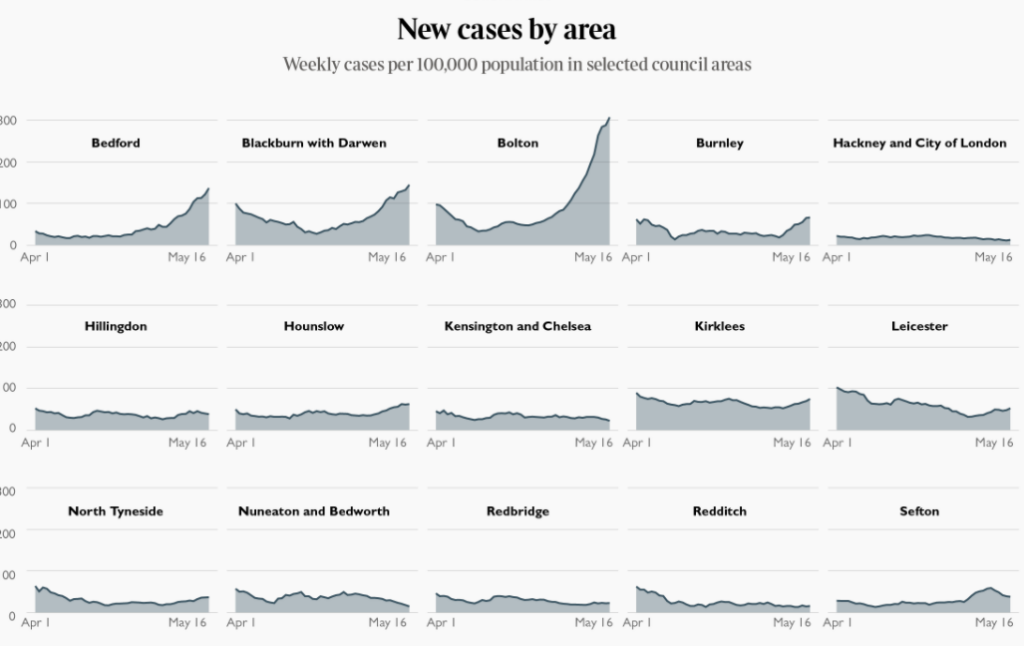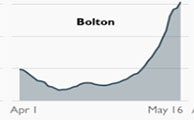27 May 2021
Lies, Damned Lies and Coronavirus
Indian Summer?
By David Chilvers
 There has been a lot of discussion in the last couple of weeks about the Indian Variant of Concern, and whether this might impact on the final step of the roadmap back to freedom. Will we have a summer return to normality or will it be an Indian Summer, dominated by this new variant? The initial cases of the variant were found in two areas in the North West – Bolton and Blackburn with Darwen – but have now spread to more than 100 Local Authority Areas, although many have just one case. The early indications are that the variant is more transmissible than the Kent variant but that the current vaccines protect as well against it as they do for the previous variants. On Friday night the Government quietly updated its coronavirus website, with restrictions for eight areas, apparently without informing anyone in those areas. But yesterday, it changed its mind and effectively removed these restrictions. So, what is going on, what is driving the spread of this new variant and what is the data telling us about its impact and how much of an issue is it likely to be?
There has been a lot of discussion in the last couple of weeks about the Indian Variant of Concern, and whether this might impact on the final step of the roadmap back to freedom. Will we have a summer return to normality or will it be an Indian Summer, dominated by this new variant? The initial cases of the variant were found in two areas in the North West – Bolton and Blackburn with Darwen – but have now spread to more than 100 Local Authority Areas, although many have just one case. The early indications are that the variant is more transmissible than the Kent variant but that the current vaccines protect as well against it as they do for the previous variants. On Friday night the Government quietly updated its coronavirus website, with restrictions for eight areas, apparently without informing anyone in those areas. But yesterday, it changed its mind and effectively removed these restrictions. So, what is going on, what is driving the spread of this new variant and what is the data telling us about its impact and how much of an issue is it likely to be?
To answer this, we have looked at the latest local area data on the number of cases (the number of positive test results), which is for the week ending 19th May. The finest geographical breakdown available in England and Wales is the Medium Level Super Output Area (MSOA). There are 7,201 of these areas in England and Wales with an average 8,250 individuals in each. The Office for National Statistics updates a file each day with case numbers for each MSOA; however, to protect individuals, the data is suppressed if the number of cases is less than three. In the latest week ending 19th May, 5,779 MSOA’s had their data suppressed in this way, leaving just 1,422 with three or more cases (positive test results) in the week.
As we have done previously, we have matched this data back to 2011 Census data at MSOA level. Although this is eleven years old now, the profiles of most MSOAs are unlikely to have changed dramatically. We can then use this data to calculate the positivity rate for each MSOA and also see whether the MSOA’s with the highest case rates have any particular characteristics. To do this, we have sorted the MSOA’s into declining case rates and looked at the characteristics of the top 10 (the 10 MSOA’s with the highest case rates) and the top 50. We have then identified the characteristics where the top 50 are most different from the overall average. The table below shows the ten characteristics which are most pronounced in the top 50 MSOA’s.
| average | top 10 | top 50 | top 50/average | |
| case rate | 0.08% | 1.03% | 0.48% | |
| Asian | 10.22% | 30.59% | 20.98% | 205% |
| Travel to Work: Taxi | 0.42% | 1.14% | 0.76% | 182% |
| Econ inactive: Looking after home or family | 4.86% | 8.65% | 6.67% | 137% |
| Econ inactive: Other | 2.62% | 4.17% | 3.30% | 126% |
| Econ inactive: Long-term sick or disabled | 4.54% | 6.84% | 5.65% | 124% |
| Occupation: Process plant/machine operatives | 8.14% | 11.73% | 10.03% | 123% |
| Social Grade: DE Semi-skilled/unskilled manual | 27.79% | 42.67% | 34.11% | 123% |
| Industry: C Manufacturing | 9.25% | 11.19% | 11.24% | 122% |
| Deprivation: 3 out of 4 measures | 6.09% | 8.90% | 7.30% | 120% |
| Two or more self-certified illnesses | 7.19% | 9.34% | 8.62% | 120% |
The “average” column shows the average of all 1,422 MSOA’s with three or more cases in the week ending 19th May. The top 10 shows the same figures for the 10 MSOA’s with the highest case rates, similarly the top 50. The final column shows how the top 50 figure compares to the average.
So, if we look at the row headed “Asian” we can see that in all 1,422 MSOA’s, 10.22% of the population was Asian; in the MSOA’s with the 10 highest case rates, 30.59% was Asian; and in the MSOA’s with the 50 highest case rates, 20.98% of the population was Asian. This last figure is 205% of the average figure across all 1,422 MSOA’s. We know from previous analysis that COVID-19 has disproportionately affected ethnic minorities, those in low skilled jobs that cannot easily work from home, those in deprived areas and those with pre-existing health conditions; this analysis of case rates in the week ending 19th May confirms this with disproportionate numbers among:
- Those of Asian ethnicity
- Those economically inactive
- Those working in manufacturing and/or as machine operatives
- Those in Social Grade DE
- Those with three out of four deprivations across employment, education, health and housing
- Those self-certifying two or more illnesses
Of the 50 top 10 MSOA’s for positive case rates in the week ending 19th May:
- 24 are in Bolton
- 8 in Blackburn with Darwen
- 5 in Bedford
- 3 in Kirklees
- 1 each in ten other local authority areas: Bedfordshire, Burnley, Calderdale, Croydon, Hounslow, Leicester, Manchester, Newcastle, Trafford and West Berkshire
This analysis supports the notion that the recent increase in cases associated with the Indian VOC are quite heavily clustered in a small number of areas, although there are small numbers of cases in many local authority areas. The list above includes all eight local authorities where additional restrictions were recommended on Friday evening (and then withdrawn).
Are the numbers of cases continuing to rise in these areas and is there any indication of the sort of exponential growth that might lead us to think this variant is causing a major problem? Looking back over the past few weeks, the table below shows the trends in case numbers for the 10 MSOA’s with the highest cases rates in week ending 19th May.
| MSOA name | LA | 05-May | 12-May | 19-May | 05-May | 12-May | 19-May |
| Lever Edge | Bolton | 36 | 94 | 155 | 89% | 161% | 65% |
| Rumworth North | Bolton | 47 | 67 | 136 | 114% | 43% | 103% |
| Rumworth South | Bolton | 34 | 79 | 116 | 79% | 132% | 47% |
| Burnden & Great Lever | Bolton | 34 | 60 | 72 | 240% | 76% | 20% |
| Daubhill & Fernhill Gate | Bolton | 26 | 57 | 55 | 189% | 119% | -4% |
| Kingsbrook | Bedford | 9 | 27 | 72 | 200% | 167% | |
| Halliwell & Brownlow Fold | Bolton | 10 | 26 | 58 | 160% | 123% | |
| Bastwell | Blackburn | 19 | 23 | 52 | 36% | 21% | 126% |
| Lammack & Revidge | Blackburn | 20 | 43 | 57 | 67% | 115% | 33% |
| Heaton & Deane | Bolton | 20 | 58 | 52 | 67% | 190% | -10% |
After the name and local authority, the next three columns show the number of cases each week and the final three columns show the percentage increase in the number of cases compared to the previous week, with the peak figure in red. For six of these ten areas, the growth rate peaked in week ending 12th May, whilst for three areas the peak growth rate was in week ending 5th May. In just one of these top ten areas was the growth rate still increasing in the week ending 19th May. This suggests that the growth is already slowing down in these areas.
Recent data published in The Times and reproduced below confirms that there has not been rapid take-off in the number of cases in areas outside Bolton, Blackburn and Bedford:

These charts include all eight areas where the Government has suggested (and then not suggested) more limited interaction, including no travel recommended into or out of the area. Apart from Bedford, Blackburn and Bolton, there seems to be no evidence of any pick up in case rates and this begs the question of why the additional five areas had been singled out for these restrictions in the first place.
If we extend this analysis to the top 50 areas, for seven the growth rate peaked in week ending 5th May, for 20 the week ending 12th May and for 23 the week ending 19th May. So, as we go down the list, there are more areas where the peak growth rate is the most recent week (and indeed may be still higher in subsequent weeks).
In summary, the MSOA’s with the highest cases rates in this recent period are already seeing growth rates slow down, whereas those with slightly lower cases rates may not have reached peak growth rates yet. Whether this is due to local surge testing constraining the variant or the variant already running out of steam remains to be seen. If the number of cases translated into hospitalisations or deaths, we would be concerned, but the evidence on this in the four most affected areas is slight (all data for the total so far in May):
| Admissions | In hospital | In ICU | Deaths | |
| Bedford | 25 | +2 | 0 | 1 |
| Blackburn | 36 | -2 | +3 | 1 |
| Bolton | 37 | +11 | +3 | 3 |
| Kirklees | 16 | +1 | 0 | 0 |
Only Bolton shows significant numbers of hospital admissions and an increase in the number in hospital with COVID-19. The data in the first three columns for Blackburn and Kirklees covers a wider area than just the local authority, so will be an overstatement of the situation in those areas.
On the basis of this evidence, the impact of the Indian VOC so far seems to be concentrated in a small number of areas. In those with the highest levels of case positivity, the growth rate already seems to be levelling off, but this may well be due to surge testing in those areas to limit spread. The impact on hospital admissions can only really be seen in Bolton. Other areas outside the current top 10 MSOA’s with above average case rates are at or below their peak growth rate, so there may be further growth in those areas. However, the restrictions suggested by the Government on Friday (and then rescinded) seem out of proportion with the growth (or lack of it) in case rates in those areas, and the watering down of the restrictions seems the right thing to do.
Above all, we see that this recent localised spike in COVID-19 cases continues to affect the same groups as have been affected before – ethnic minorities, those living in deprived areas, working in lower skilled or unskilled jobs or economically inactive and with pre-existing health conditions. One major task of the levelling up exercise so loved by this Government will be to try and rectify some of those inequalities which not only affect life generally but also susceptibility to this disease.
This article is one of a series, last week’s article on strange diversions between the various mortality statistics is here.


